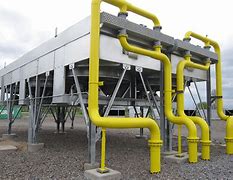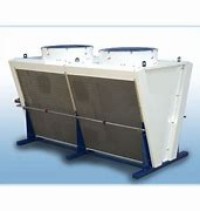How A Dry Cooling Tower Works ?
A dry cooling tower, moreover known as an air-cooled heat exchanger, works on the guideline of utilizing encompassing discuss to cool a working liquid, such as water or a handle liquid, without coordinate contact between the discuss and the liquid. Not at all like damp cooling towers, which utilize evaporative cooling, dry cooling towers exchange heat through convection and conduction without including water vanishing. Here’s how a dry cooling tower works:
1. Heat Exchange Surface:
A dry cooling tower comprises of a expansive heat trade surface, regularly made up of finned tubes or other structures. This surface encourages the exchange of heat from the hot liquid (such as water from an mechanical prepare or a control plant) to the encompassing discuss.
2. Working Liquid Circulation:
The hot working fluid circulates through tubes or other heat trade components inside the dry cooling tower. This liquid carries heat vitality that should be disseminated to preserve the required temperature.
3. Air Circulation:
Expansive fans are introduced on the dry cooling tower to force surrounding discuss over the heat trade surface. The development of discuss helps within the expulsion of heat from the working liquid.
4. Heat Dissipation:
As the hot working liquid streams through the tubes, heat is exchanged from the liquid to the metal surfaces. The fans make a stream of surrounding discuss over these surfaces, retaining the heat and carrying it absent from the tower.
5. Heat Rejection:
The retained heat is rejected into the air, and the now-cooled working liquid exits the dry cooling tower to return to the mechanical prepare or framework it serves.

6. Condensation (In Some Applications):
In certain applications, such as control plants, the dry cooling tower may be utilized for condensing steam from a control era cycle. In this case, the steam is condensed on the outside surface of the heat trade components.
7. Effectiveness and Performance:
The execution of a dry cooling tower depends on variables such as surrounding discuss temperature, stickiness, and the plan of the heat trade components. Dry cooling towers are for the most part less proficient than damp cooling towers but are favored in locales where water accessibility is restricted or natural contemplations limit the utilize of water.
8. Maintenance Considerations:
Dry cooling towers are frequently favored in mechanical applications where water preservation is basic or where the treatment of cooling water can be challenging. They require less support than damp cooling towers as there’s no water dissipation and potential issues related with water treatment.
9. Environmental Impact:
Dry cooling towers have a lower natural affect in terms of water utilization, but they may have somewhat lower productivity compared to damp cooling towers, particularly amid high-temperature conditions.
Whereas dry cooling towers offer points of interest in water preservation and diminished support, they may have lower heat productivity compared to damp cooling towers, especially in hot and dry climates. The choice between dry and damp coolingtowers depends on components such as water accessibility, natural directions, and the particular prerequisites of the mechanical prepare or control era application.


[…] Cooling towers play a pivotal part in disseminating heat from industrial forms and HVAC systems. Legitimate support is basic to guarantee their effective and solid operation. Here’s a comprehensive direct on the maintenance of cooling towers: […]
[…] Dry cooling towers have experienced critical advancements in later years, driven by the require for more proficient and sustainable cooling arrangements in different businesses. Here are a few of the key headways forming the advancements in dry cooling tower technology: […]